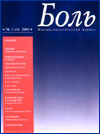Analgesic effects of flecainide on post herpetic neuralgia
Analgesic effects of flecainide on post herpetic neuralgia
Masahiko Ichimata, Haruyoshi Ikebe, Hitoshi Yamamoto, Sigenori Yoshitake,Hideo Iwasaka and Takayuki Noguchi Dept. of Anesthesiology, Oita Medical University, Oita, Japan
Aim of investigation: Sodium-channel blockers have been reported to improve clinical neuropathic
pain. However, oral administration of a sodium-channel blocker such as mexiletine often does not reduce
neuropathic pain, despite the efficacy of intravenous lidocaine administration. The class Ic antiarrythmic
agent flecainide is a commercially available potent sodium-channel blockers. The purpose of this study
was to evaluate the analgesic effects of flecainide on neuropathic pain in patients with post herpetic
neuralgia.
Results: Fourteen patients judged as responders. In the 14 responders. 100mg/day of the oral flecainide did not improve their neuropathic pain nor reduce VAS significantly. In all responders. 200mg/day of the oral flecainide administration during four weeks lessened their neuropathic pain and reduces VAS significantly from 35.0± 13.1mm to 15.0± 14.4mm (mean±SD).
Conclusion: The analgesic effect of 200mg/day of the oral flecainide can be judged by the effectiveness of intravenous administration of flecainide. These results suggest that flecainide is useful for the treatment of neuropathic pain in patients with post herpetic neuralgia.
Herpes zoster and motor involvement. A seldom evaluated complication. A two case report and some practical consideratons
Elena Catala, Marta Ferrandiz, Isabel Ilia, Luis Aliaga, JM Villar Landeira.
Pain Clinic and Neurology service. University hospital de la Santa Creu i Sant Pau. 08025 Barcelona,
SPAIN
Introduction: Pain and sensory disturbances are the main complications of Herpes Zoster (HZ).
In contrast the motor involved is considered very rare or even not considered by some of the primary
care physicians (pep) leading to additional patient anxiety and suffer. We present two case of different
HZ localitazion with pain and motor involvement.
Case 1.- An 80-year-old woman referred by her pep to our Pain Clinic due to a PHN. The patient
was suffering from a lancinating and burning pain in her right thoracic region ( T10- T12).
Physical examination showed an intense allodynia and hyperesthesia of this area and a distension on
the right part of the abdomen in contrast with her left side. After two months of oral treatment with
Gabapentin 1200 mg /day and Metamizol 1800 mg/day patient pain decreased dramatically but her right
abdomen side continued distended causing severe patient anxiety. The electromyography (EMG) showed
a denervation in paravertebral muscles D10- L4 months after HZ. Polyphasic motor
units (reinervation) were found.
Case 2.- A 58-year-old woman who developed a right lumbar HZ infection after the chimiotherapy
treatment for a cancer process. She complained of pain in her right leg describing it as a lancinating.
Clinical examination was significant for sensory loss in the right anteromedial thigh , some atrophy
of her right quadriceps muscle (2/5) and decrease in right patellar reflex. Her left lower limb was
normal. The EMG showed a L3-L4-L5 right axonal polyradiculopathy
secondary to the HZ infection. After 2 months of treatment with Gabapentin 1600 mg/day and physiotherapy
the patient was pain free and only a slight motor deficit remained.
Conclusion: The HZ virus is not only a unique form of sensory neuritis but motor function involvement
suggests that it is also a widespread infection. It is important to be aware of this implication for
the following reasons: 1.- To avoid other complementary tests to explore other pathologies. 2.- The
prognosis is good and it is important to inform the patient. 3.- A rehabilitation program should be
incorporated when a limb is affected.
Pain in Europe III. EFIC 2000, Nice, France, September 26-29, 2000. Abstracts book, p. 248, 271.






